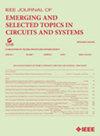Building Time-Surfaces by Exploiting the Complex Volatility of an ECRAM Memristor
IF 3.7
2区 工程技术
Q2 ENGINEERING, ELECTRICAL & ELECTRONIC
IEEE Journal on Emerging and Selected Topics in Circuits and Systems
Pub Date : 2023-11-16
DOI:10.1109/JETCAS.2023.3330832
引用次数: 0
Abstract
Memristors have emerged as a promising technology for efficient neuromorphic architectures owing to their ability to act as programmable synapses, combining processing and memory into a single device. Although they are most commonly used for static encoding of synaptic weights, recent work has begun to investigate the use of their dynamical properties, such as Short Term Plasticity (STP), to integrate events over time in event-based architectures. However, we are still far from completely understanding the range of possible behaviors and how they might be exploited in neuromorphic computation. This work focuses on a newly developed Li利用 ECRAM Memristor 的复杂波动性构建时间曲面
忆阻器能够充当可编程的突触,将处理和记忆功能整合到单个设备中,因此已成为高效神经形态架构的一项前景广阔的技术。虽然晶闸管最常用于对突触权重进行静态编码,但最近的研究工作已开始研究如何利用其动态特性,如短期可塑性(STP),在基于事件的架构中整合随时间变化的事件。然而,我们还远远没有完全了解可能的行为范围以及如何在神经形态计算中利用这些行为。这项工作的重点是新开发的基于 Li $_{\text {x}}$ WO $_{\text {3}}$ 的三端忆阻器,它具有可调的 STP 和以双指数衰减为模型的电导响应。我们根据实验数据推导出了该器件的随机模型,并研究了器件随机性、STP 和双指数衰减如何影响分层时间表面(HOTS)架构的精度。我们发现,设备的随机性不会影响准确性,STP 可以减少基于事件的传感器信号中的椒盐噪声的影响,而双指数衰减则可以通过整合多个时间尺度上的时间信息来提高准确性。我们的方法可以推广到对其他记忆器件的研究中,从而更好地理解对时间动态的控制如何使神经形态工程师能够对器件和架构进行微调,以适应手头的问题。
本文章由计算机程序翻译,如有差异,请以英文原文为准。
求助全文
约1分钟内获得全文
求助全文
来源期刊

IEEE Journal on Emerging and Selected Topics in Circuits and Systems
ENGINEERING, ELECTRICAL & ELECTRONIC-
CiteScore
8.50
自引率
2.20%
发文量
86
期刊介绍:
The IEEE Journal on Emerging and Selected Topics in Circuits and Systems is published quarterly and solicits, with particular emphasis on emerging areas, special issues on topics that cover the entire scope of the IEEE Circuits and Systems (CAS) Society, namely the theory, analysis, design, tools, and implementation of circuits and systems, spanning their theoretical foundations, applications, and architectures for signal and information processing.
 求助内容:
求助内容: 应助结果提醒方式:
应助结果提醒方式:


